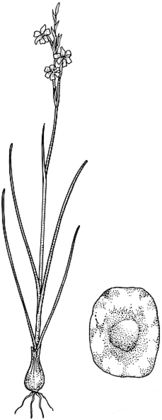
Description: Perennial herbs with annual leaves and flowers; corms globose or ovoid, tunic fibrous to papery.
Leaves 1–several, basal, sword-shaped, lanceolate or linear, flat to almost terete in section, tough, fibrous; cauline leaves reduced, bract-like.
Spike secund or more or less distichous. Scape erect, terete, unbranched; spathe bracts green, lanceolate, inner one shorter, 2-toothed to 2-fid, occasionally tubular below; spathes 1-flowered. Flowers zygomorphic [rarely actinomorphic], often somewhat fragrant, variously coloured, outer 3 tepals narrower than inner; tepals basally connate into a perianth tube straight or usually curved, cylindrical to funnel-shaped; free lobes subequal to very unequal, sometimes clawed at base or 2-lipped, with nectar-guide markings on outer lobes. Stamens usually grouped on 1 side of the style. Style filiform, 3-branched; branches entire, widened at apices.
Capsule oblong to ellipsoidl or ovoid, papery to leathery, often with prominent reticulate veins; seeds numerous, flat, winged [rarely wingless], brown.
Distribution and occurrence: World: c. 260 species, Africa, Madagascar, Eurasia. Australia: 15 species (naturalized), all States except N.T.
Numerous large-flowered Gladiolus hybrids are cultivated and may occur as garden escapes, but are not truly naturalized.
Text by T. A. James & E. A. Brown (1993); edited KL Wilson (Oct 2015)
Taxon concept:
| | Key to the species | |
| 1 | Perianth c. 3 cm long; leaves somewhat fleshy, far exceeding the inflorescence | Gladiolus gueinzii |
| Perianth more than 3 cm long; leaves never fleshy, hardly exceeding the inflorescence | 2 |
| 2 | Perianth tube about twice as long as lobes | Gladiolus angustus |
| Perianth tube about equal to lobes
Back to 1 | 3 |
| 3 | Perianth lobes acute, variably undulate | 4 |
| Perianth lobes long-acuminate with tapering, markedly undulate tips
Back to 2 | Gladiolus undulatus |
| 4 | Perianth lobes narrow-elliptic, 2–3 times as long as wide | Gladiolus carneus |
| Perianth lobes broad-elliptic (at least the uppermost 3), about as long as wide
Back to 3 | 5 |
| 5 | Perianth lobes all similar in size | Gladiolus x hortulanus |
| Uppermost 3 perianth lobes much bigger than (about twice the size of) lower 3 lobes
Back to 4 | Gladiolus dalenii |
|


